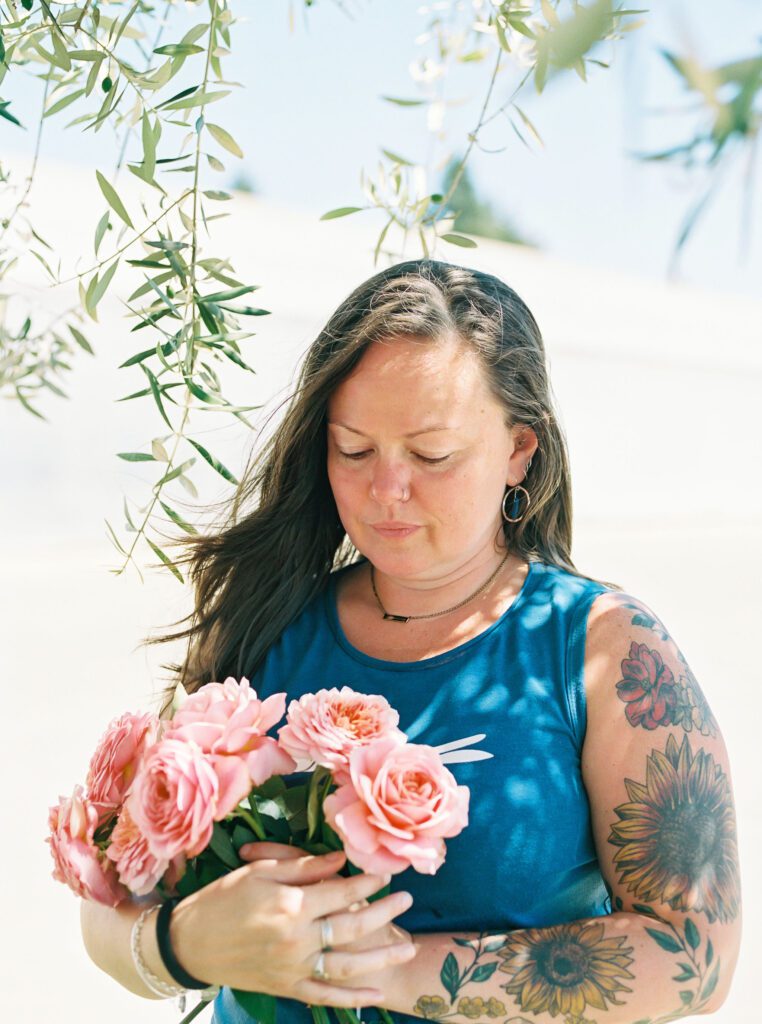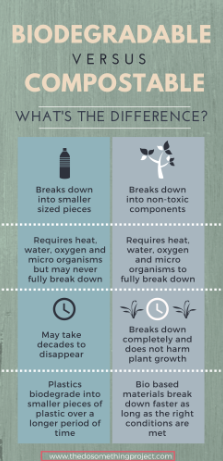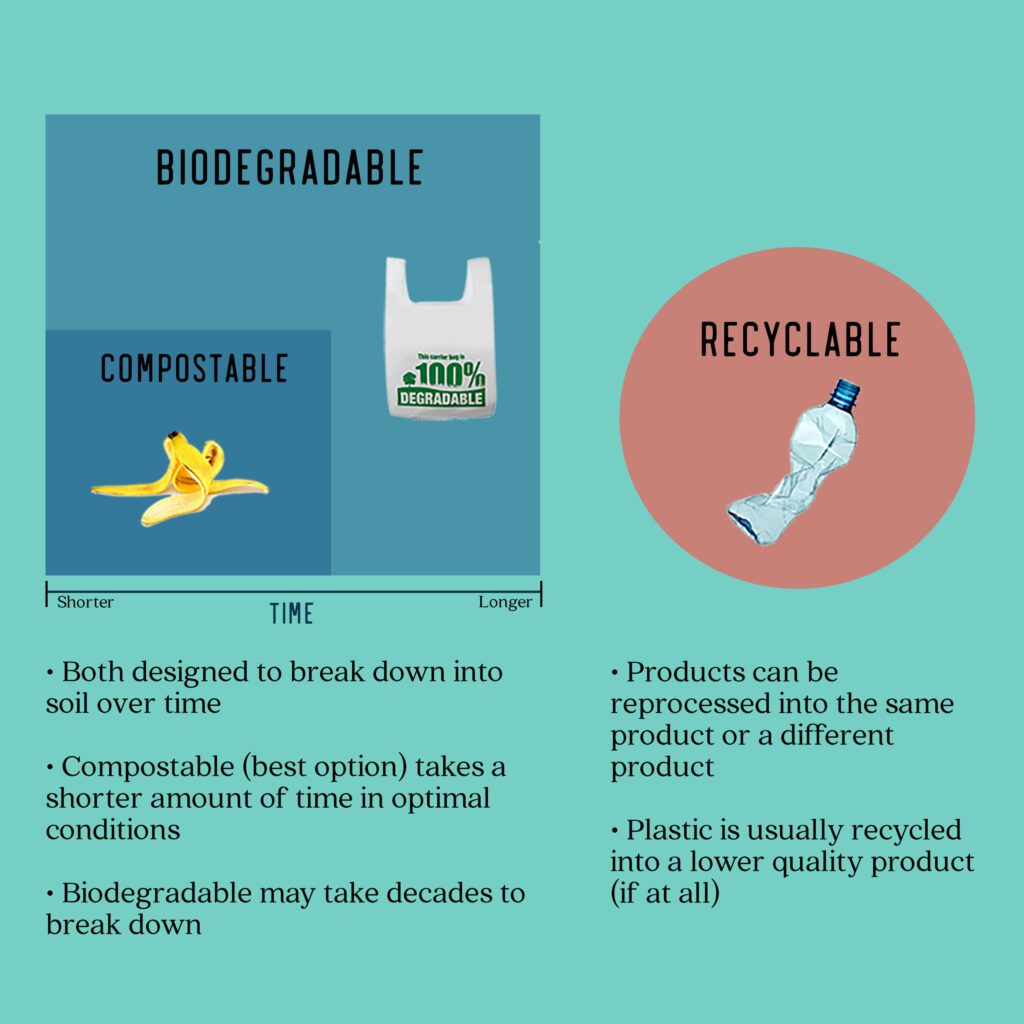How ‘Low Waste’ became my mantra
March 13, 2024
These days, there are so many buzz words flying around the sustainability world. I find it difficult to sort through which ones mean what, and which ones are actually useful to me. Some of these words sound better than they are and many companies use them to make their products look better. This is called
GREENWASHING
It’s hard to know what choices to make or what will be the most impactful decision. Let’s start with some definitions.

Biodegradable
Biodegradable means is that something is able to be broken down into smaller particles by bacteria or other living organisms. The term is not regulated and there is no time limit for biodegradation. Did you know that everything will break down eventually, if given enough time, even glass and metal! If the product is a biodegradable plastic, or bioplastic, it requires intense heat only available at industrial composting facilities and landfills in order to be able to properly break down into smaller parts.
Assuming the materials DO properly breakdown, most bioplastics leave residues behind that are not helpful, it’s just smaller pieces of plastic: microplastics. More troubling, most conventional landfills aren’t even capable of providing the correct type of environment, so, oftentimes, people send their bioplastics to the landfills, thinking they’ve done the right thing, and the product isn’t able to break down the way it’s supposed to.
Landfills also give off greenhouse gases created by the breakdown of these materials – yes, read that again. The products that are made to be eco-friendly end up giving off greenhouse gasses in the landfill.
If biodegradable isn’t a word we can count on, what other words can we look for?

Compostable
All compostable products are biodegradable, but biodegradable products are not always compostable. The main difference is that compostable products have undergone strict testing and meet standards to ensure that they break down in a timely manner at a rate consistent with similar organic materials and will not release harmful residue or toxins into the environment.
Compostable products add value to the planet’s ecosystem by decomposing into nutrient-rich compost. Packaging that is labeled as compostable should be disposed of in a compost bin, NOT the regular trash. If you can’t compost at your own studio, often your city or county will pick up compostable waste and dispose of it for you!
The most obvious example of this would be all your organic waste that comes from trimming and removing leaves from your flowers each week. But there are other products in the floral world that are compostable, my favorite of which are LovaCandles.
Recyclable
If something is recyclable, the material can be collected and treated in such a way that those materials can be used to create new materials that be be used again. Obvious examples of recyclable items you probably have around your studio are BOXES!! Amiright? Most florists are drowning in boxes. Lesser known items that are recyclable are the plastic sleeves that are wrapped around your flowers (keep reading for a helpful blogpost on that), the cardboard sleeves from your flowers, plastic flower food containers, and, of course, broken vases.

Reusable
Reusable simply means that a product can be used again, at least, more than once. There are so many examples of this in the floral world, but obvious ones would be your tools, any chicken wire burritos or mechanics that you fashion (we have a giant bin dedicated to reused chicken wire), flower frogs, packing material, rubber bands, rentable vases/arches, and floral buckets.
When thinking about a guiding principle for my business, I try to think about “Low Waste.”

To me, this seems to encompass all of the above, but it also best conveys my intent and the Sustainability component of my CORE Values. To that end, here are some things that Sweet Blossoms does to ensure that my company is a Low Waste company, as much as possible.
- Recycle or reuse all cardboard and hard plastic materials that come into the studio
- I no longer create ANY designs using floral foam
- I have an extensive rental inventory and wherever possible, I choose to rent to my clients instead of selling vessels to clients and placing the burden on them to recycle/dispose of them appropriately.
- I repurpose the remaining petroleum-based candle inventory into retail candles (You can purchase them here) and the majority of our event candles have been transitioned into non-petroleum based, compostable candles (more on that here).
- After an event, all designs are taken apart and reduced to their compostable and reusable parts. Organic waste goes in the compost pile. Tubes, water receptacles, and vases are washed. Reusable mechanics are returned to their holding bins. Any tape or wire that was used is thrown away (low waste).
- I reuse boxes and packing materials from vase shipments to help pack up designs for my events.
- I buy local flowers whenever possible, which reduces my carbon footprint by using less fuel. Local farmers are also less likely to package flowers in plastic.
- I don’t paint flowers, which creates trash out of something that was already compostable.
There’s one other thing I’d like to touch on, which can (and likely will) be a whole other post one day. It’s really HARD to make this change, away from floral foam, all in one fell swoop. Kudos to anyone who does, I sure didn’t!
Any change that you can make, towards using less foam, or being more sustainable in general, is a positive one – no matter how small!
This is not a purity test. It’s not all or nothing. You don’t have to be perfect! If you are sitting here reading all of this and thinking, there’s no way I can fully eliminate foam, or there’s no way I can do all of the things Blair is recommending, THAT’S OKAY! Maybe you can remove foam from your low arrangements for right now. Then maybe you remove them from one more design. Small steps are WAY better than NO steps.
Click here for more on Sustainability at Sweet Blossoms. I also have a page dedicated to Sustainability on my website that I try to keep updated. I am always available to chat, and also for studio consulting.
Here are some other resources that might be helpful.
- Sue McLeary foam-free online courses
- Flower Frogs – can be added to dip bowls for a pincup look, or vases to anchor your stems
- Floral pillows – can be reused on top of urns or in arch designs
- Oshun Pouches – a foam alternative. This company also sells bamboo cardette holders for retail shops!
- Sue McLeary also has a List of Reliables for foam free work
- The Sustainable Floristry Network
- Slow Flowers Society
- Afloral also has a helpful foam-free supply section
- School of Sustainable Floristry – if you feel like studying abroad
- Joseph Massie’s Wedding Masterclass is completely foam-free